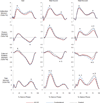Three-dimensional knee moments of ACL reconstructed and control subjects during gait, stair ascent, and stair descent
- PMID: 23141637
- PMCID: PMC3552088
- DOI: 10.1016/j.jbiomech.2012.10.010
Three-dimensional knee moments of ACL reconstructed and control subjects during gait, stair ascent, and stair descent
Abstract
Changes in knee mechanics following anterior cruciate ligament reconstruction (ACLR) have been implicated as a contributor to the development of premature osteoarthritis (OA). However, changes in ambulatory loading in this population have not been well documented. While the magnitude of the external knee moment vector is a major factor in loading at the knee, there is not a comprehensive understanding of the changes in the individual components of the vector following ACL reconstruction. The purpose of this study was to test for differences in the three components of the external knee moment during walking and stair locomotion between ACLR, contralateral and healthy control knees. Forty-five ACLR and 45 healthy control subjects were tested during walking, stair ascent and descent. ACLR knees had a lower first peak adduction moment than contralateral knees during all three activities. Similarly, additional cases of significant differences between ACLR and contralateral knees consisted of lower peak moments for the ACLR than the contralateral knees. These differences were due to both ACLR and contralateral knees as the ACLR knees indicated lower and the contralateral knees greater peak moments compared to healthy control knees. The results suggest a compensatory change involving greater loading in the contralateral knee, perhaps due to lower loading of the ACLR knee. Further, lower knee moments of the ACLR knee suggest that increased joint loading may not be the initiating factor in the development of OA following ACL reconstruction; but rather previous described kinematic or biological changes might initiate the pathway to knee OA.
Copyright © 2012 Elsevier Ltd. All rights reserved.
Conflict of interest statement
The authors have no conflict of interest to disclose.
Figures


References
-
- Andriacchi TP, Mundermann A, Smith RL, Alexander EJ, Dyrby CO, Koos S. A framework for the in vivo patho-mechanics of osteoarthritis at the knee. Annals of Biomedical Engineering. 2004;32(3):447–457. - PubMed
-
- Andriacchi TP, Alexander EJ, Toney MK, Dyrby CO, Sum J. A point cluster method for in vivo motion analysis: applied to a study of knee kinematics. Journal of Biomechanical Engingeering. 1998;120:743–749. - PubMed
-
- Andriacchi TP, Dyrby CO. Interactions between kinematics and loading during walking for the normal and ACL deficient knee. Journal of Biomechanics. 2005;38:293–298. - PubMed
-
- Andriacchi TP, Johnson TS, Hurwit DE, Nataraja RN. Musculoskeletal dynamics, locomotion, and clinical applications. In: Mow VC, Huiskes R, editors. Basic Orthopaedic Biomechanics and Mechano-Biology. 3rd ed. Philadelphia, PA: Lippincott Williams & Wilkins; 2005. pp. 91–122.
-
- Andriacchi TP, Mundermann A. The role of ambulatory mechanics in the initiation and progression of knee osteoarthritis. Current Opinion in Rheumatology. 2006;18(5):514–518. - PubMed
Publication types
MeSH terms
Grants and funding
LinkOut - more resources
Full Text Sources
Other Literature Sources
Medical

